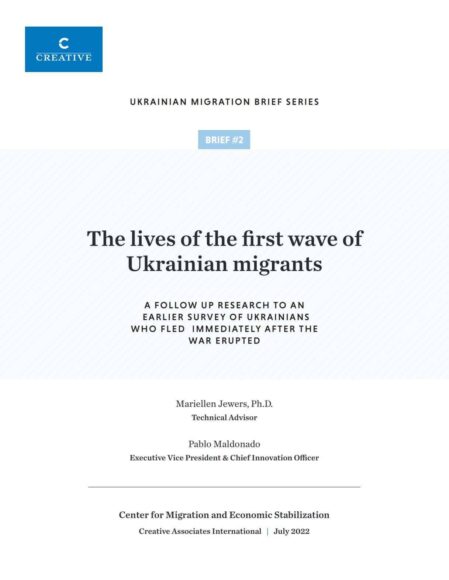Ukrainians who fled Russia’s invasion rely on outside remittances for financial stability while continuing to seek jobs for financial security, all in the hope of returning to Ukraine when it’s safe. For many Ukrainians who fled at the start of Russia’s February invasion, the past several months have meant constantly relocating in search of housing and employment stability.
A significant number of them—42 percent—reported moving from the country where they initially landed during the first few weeks of the invasion to a new location, while 63 percent of Ukrainian refugees said they intended to stay in their current location for less than a year, according to the results of a June survey conducted by Creative Associates International’s Center for Migration and Economic Stabilization.
Overshadowing the seemingly endless relocations is one constant: Ukrainians’ strong intentions to return to their country when it is safe to do so, rather than settle permanently in Poland, Romania or other nations that have welcomed nearly 8 million displaced by war, the study showed.
Ten percent of families in the study that lived abroad had already returned to Ukraine by June, the study said. Still, Russia has destroyed thousands of homes, devastated cities in Ukraine’s east and occupied large swaths of the country’s east and southeast, leaving nothing for hundreds of thousands of displaced Ukrainians to return home to.
“While it is evident that Ukrainians are determined to return home, the ability to return is reserved primarily for those that can return to their hometowns,” says Mariellen Jewers, a technical advisor at Creative’s Center for Migration and Economic Stabilization.
The June survey of Ukrainian refugees is the second in a series the Center conducted to better understand the motivations and needs of Ukrainians affected by the war with Russia. The first survey, conducted in April among 520 Ukrainians who had fled within the first few weeks of the invasion, revealed the population’s demographic makeup, as well as their financial resilience and adjustments abroad.
Seventy-seven percent of refugees who responded to the first study also responded to the new survey. This gives the Center a clearer picture of how Ukrainian families are navigating their lives and pursuing livelihoods despite the uncertainties of war.
In the first survey, the Center found this population to be highly educated and mobile. The majority were employed in Ukraine before the war, and some were working remotely at the time, says Pablo Maldonado, Creative’s Executive Vice President and Chief Innovation Officer.
A key takeaway from the second survey concluded that Ukrainians who migrated since the Russian invasion did so for safety and security reasons, not economic reasons, he says.
“The second survey also reaffirmed with emphasis something that was hinted at in moments of despair and greatest uncertainty—that Ukrainians want to go back to Ukraine. It’s worth noting that Ukrainians have continued to travel to destinies around the world, yet their stated intent to go back [home] seems firm,” Maldonado says.

Attempting to settle in, even if temporarily
Refugees reported taking several steps to adjust to life in their host countries, although most of those steps were not geared toward permanent residency, the survey shows. Some 87 percent of Ukrainians surveyed said they had made attempts to get a job, find permanent housing and learn the local language. However, respondents reported that taking these steps did not deter their intention to return to Ukraine, when possible, the survey said.
In fact, the June survey found that families’ intention to return to Ukraine as their next move, rather than move on to another location abroad, has increased substantially from their sentiments expressed in April, as did their optimism about the possibility of doing so. About one-third of respondents in the June survey said they intended to return to Ukraine in less than a year.
Finding financial stability
Ukrainian refugees’ reliance on cash transfers nearly doubled from April to June, while the number of families receiving remittances during that time increased modestly, the Creative’s study reports. A majority of families, 69 percent, said in June they were optimistic that they would continue to receive remittances without interruption, compared with 43 percent of families who expressed the same confidence in the April survey.
Only 4 percent of the refugees in the June survey said they were employed, down from 10 percent in April. The number of refugees looking for work during that time increased. In April, respondents said they feared facing issues regarding recognition of their education when asked about how they perceived looking for a job in their host countries. In June, respondents said not knowing the local language was the most common obstacle to finding a job, followed by concerns over migrants getting employment in a tight labor market and family responsibilities.
“Despite policies that allow for Ukrainians to work and live with temporary protected status in European countries, families in our study are still struggling with finding appropriate employment in host countries,” Jewers says.
Understanding the status and needs of Ukrainian refugees will be essential for practitioners to create an integrated approach of development and humanitarian efforts to support them.
“Our data highlights that development needs must be integrated into humanitarian efforts to support refugees that remain abroad as well as Ukrainians that are returning to their hometowns,” Jewers says.
Creative’s Center for Migration seeks to find development opportunities in dramatic shifts, whether social or economic, Maldonado says.
“Creative does not aim to respond to the humanitarian crisis per se but to be one step ahead of the curve: identifying and designing for the needs and the opportunities that arise from this crisis,” he says. “Understanding the drivers of migration with increased clarity, we seek to foment security and stability to foster the conditions for a return to Ukraine at scale to prevent future waves of migration due to instability or poor economic conditions.”